
The Stealth is a new ultralight tarptent from UK gear maker Trekkertent that combines a simple design with a diverse range of capabilities for lightweight adventures. I’ve been testing one of the first product models available for the past several months and like the simplicity and classic design of the Stealth which has a built-in vestibule which can be closed or left open, and an optional inner tent that can be added to the tarp when you want increased comfort or bug protection.
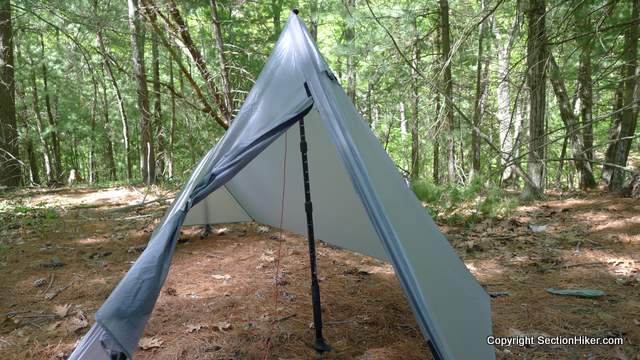
There was a time when many UL companies produced shelters like the Stealth, but the market has moved away from this design to increasingly complex “contraptions” which are more difficult to pitch, have many more points of failure, and are heavy or outrageously expensive in comparison. If you’re like me and dissatisfied with the complexity, and price of most available UL shelters today, you’re looking for your first affordable and highly functional UL shelter, or want an easy-to-pack shelter suitable for ultralight backpacking or bikepacking, I recommend you give the Stealth a good look. It’s not a palace, but it’s a damn good value that doesn’t require a huge amount of skill to use or enjoy.

As the Stealth’s name implies, this shelter is good for pitching in non-designated campsites and wilderness locations where you want to pitch camp for the night and leave no trace. Though only available in grey (I wish a dark green color was available), the Stealth has a low enough profile and height that it visually disappears into the forest understory when pitched in heavy vegetation or mountainous terrain.

The Stealth also has an uncanny ability to fit into very narrow or small spaces in dense woods, requiring little more of a space than a bivy bag, which is handy if good pitches and flat open ground are scarce. This is an important shelter selection criteria for me, since I primarily backpack in heavily forested mountainous terrain of New England and pick campsites on-the-fly without pre-scouting them.

Pitching the Stealth is very straightforward. Simply spread the tarp on the ground, loosen the corner linelocs and stake the corners. Next insert the carbide tip of a trekking pole through a metal loop attached to the rear of the shelter and stake it down with the rear guy line, adjusting the rear sides as necessary. Do the same at the front of the tent, but this time insert the carbide tip of your trekking pole into an interior grommet on the underside of the ridgeline.

When setting the front of the shelter, you can pitch it with the vestibule open or closed. I keep the vestibule closed when packed and during set up because I sometimes pitch the shelter in the rain. I also prefer storing the inner separate from the fly and attaching it after the fly has been set up to avoid making it more wet than necessary when pitching on wet ground. That’s one of the nice things about this shelter – the ability to add the inner tent after the fly has been set up (in the rain, for instance).
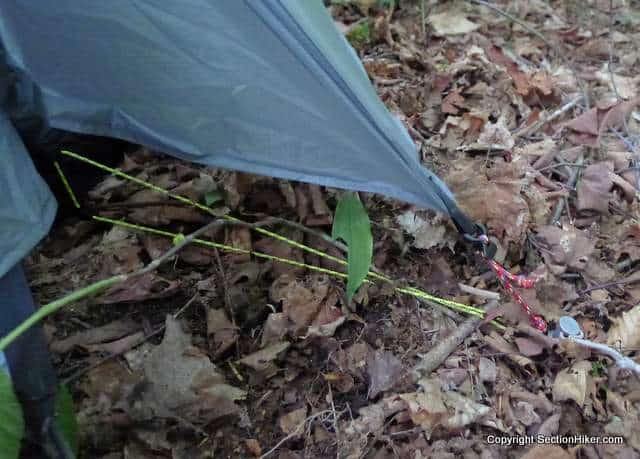
The inner tent attaches to a rings on the interior of the ridgeline using dowels that are inserted through plastic loops. The inner corners are then staked using the same stakes as the fly, so that the shelter requires 6 stakes total.
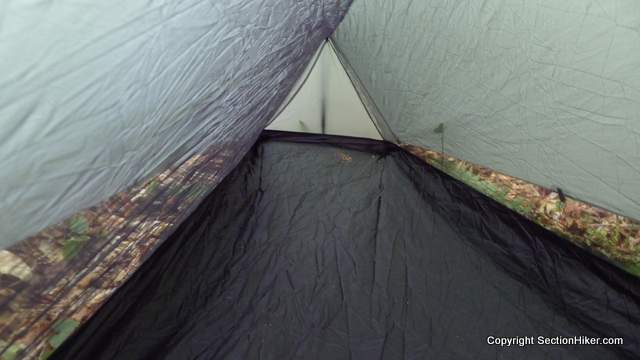
When the inner tent is hung, there is good separation between it and the outer fly to prevent internal condensation transfer. While not massive, the inner tent is comfortable and wide enough to fit a regular sized Therm-a-Rest Neoair, and personal gear along each side of the mattress within easy reach. While it is also possible to fully sit up inside the inner tent, you’ll need (and want) to keep your head at the vestibule end of the inner for better ventilation and to get in and out of the shelter.
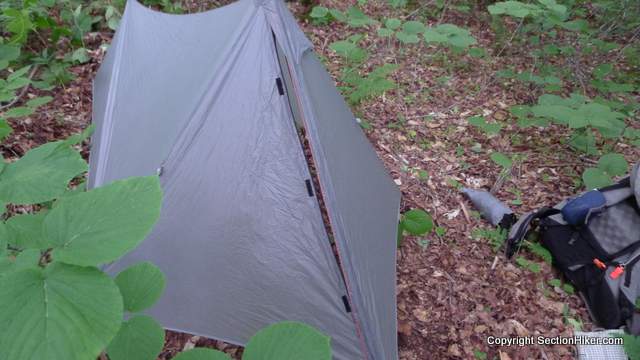
Vestibule Pitching Options
There are several ways to configure the vestibule when you pitch the tent or to modify it during the night depending on precipitation, humidity, or wind conditions. The vestibule has a two-way center zipper in addition to velcro strips which can be used when you still want to maintain a bit of airflow. Each vestibule door can also be staked closed independently or rolled back open and held in place with a keeper toggle. Alternatively, you can roll both doors back and use The Stealth as a A-frame cat cut tarp in dry weather for maximum ventilation. My preferred pitch is to keep one door rolled back for ventilation and one door staked forward to provide dew protection for my backpack and shoes at night.

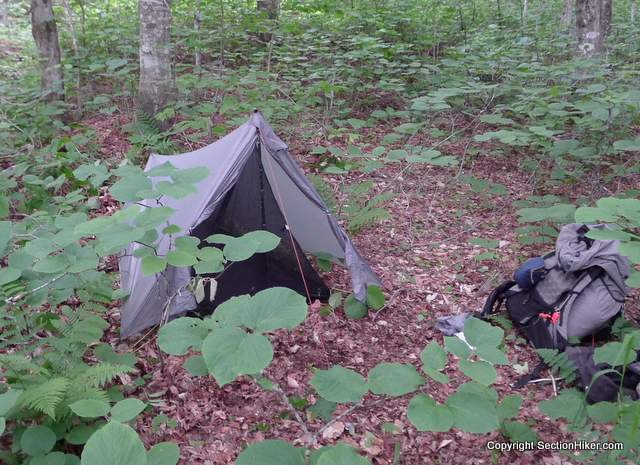
Recommendation
I have been looking for a shelter like the Stealth for several years, one that combines the simplicity of an A-frame cat cut tarp, with a front vestibule for added weather protection, and an optional inner tent for additional comfort. The Stealth is perfect for New England backpacking in heavily forested and mountainous terrain, particularly for the leave no trace. wild camping style, off-trail campsites that I prefer to pitch up at night. It’s bomber reliable in bad weather (the factory seam sealing is great), easy to pitch in the rain without soaking the inner tent, and has a very small footprint when packed up so you have more space for food or can carry a smaller, lightweight backpack.
Honestly, the Stealth checks all my must-have boxes and has moved to the top of my UL shelter list. And at 22 ounces, including the inner tent (12.7 ounces with the fly alone), I expect that I’ll be using the Stealth for all of my personal backpacking trips for the forseeable future. Yeah, I really like it!
The Stealth Tent w/ inner retails for 150 British Pounds ($255 US dollars, when this article was published). That’s quite comparable to pricing with other silnylon tarptents made-in-the-USA, something to consider you’re concerned about purchasing a shelter made overseas.
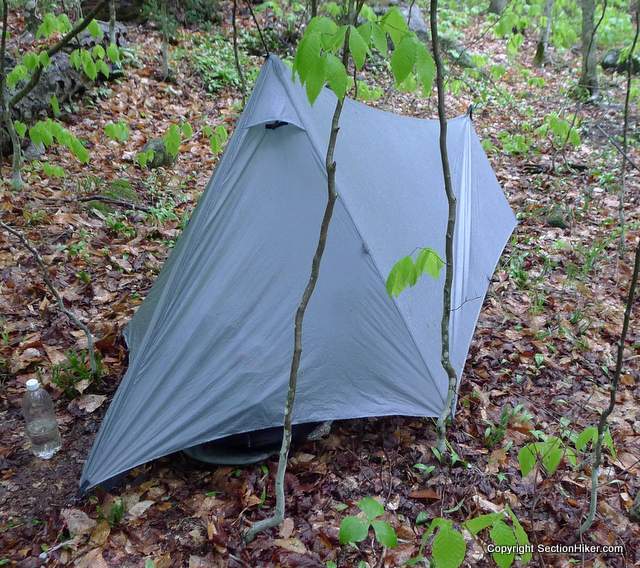
Specs
The Stealth Tent comes with an outer silnylon fly and inner tent although you can also purchase The Stealth Tarp alone from Trekkertent. The silnylon fly weighs 12.6 ounces, the inner tent weighs 9.1 ounces, including all guy outs, and cord tensioners. A 0.3 ounce stuff sack is also provided bringing the maximum shelter weight to 22.0 ounces. Both the fly and the inner tent are seam-sealed at the factory, so you don’t have to mess with it at home. Tent stakes are not included. If you don’t use trekking poles, accessory poles are available that you can use to pitch the Stealth. The company has also announced development of a cuben fiber version of this shelter. Contact Trekkertent for details.

Likes
- Can easily fit into small spaces when good campsites are scarce
- Front vestibule can be completely rolled back for better airflow
- Front pole can be lowered for a squatter, more wind resilient pitch
- Folds up into a very small package when packed
- Inner tent can be pitched after the fly to prevent it from getting wet during rainfall
- Pacerpole compatibility
Dislikes
- Rear ridgeline ring should be slightly larger in diameter to completely fit over carbide trekking pole tips
- Solid sides of the inner tent could be raised an inch or two for more piece of mind in very wet terrain.
- A rear vent with a slight overhang would help improve cross ventilation and help mitigate against nighttime foot box condensation.
Disclosure: Trekkertent provided SectionHiker.com (Philip Werner) with a sample Stealth shelter for this review.
 SectionHiker.com Backpacking Gear Reviews and FAQs
SectionHiker.com Backpacking Gear Reviews and FAQs
Nice indeed. I’m constantly on the lookout too, although still happy with my GG twinn tarp (although not the fact that they now seemingly only make it in ridiculously expensive cuben). Anyway, is the Stealth large enough for occasional use by two persons?
It would be a tight fit. So, no. That GG Twinn would be so much better with a beak. Lawton Grinter (disco) added one to his and it looks great.
On second thought, probably. You can lower the height of the pole and get a wider flatter pitch. This is intended for bad weather but would probably make it wide enough for two. The inner tent wouldn’t work though because it needs height.
This is a knock off of golite’s Shangri-la 1.
They don’t make that model anymore though.
My point exactly.
I am intrigued but have lots of questions. Without rear ventilation what is condensation like? What are basic width length height dimensions? How high is the bathtub floor? What are dimensions of the inner nest?
Unrelated but am posting early ( your time) because I have been in Europe on vaca. Just hiked the Vall Incles in Andorra yesterday. Spectacular.
All the specs are online at the mfg web site, so I won’t repeat them here. The rear condensation is not bad, but Marc at trekkertent is making all of my recommended changes including adding a rear vent and raising the sides of the inner tent a few inches.
I have always been a fan of this type of shelter and in fact have owned three variations, A Golite Hut, GG Spinnshelter and currently an MLD Patrol Shelter.
Having the bug net seperate allows for a lot more flexibility than designs with the netting attached. I consider the attached bug nets of most other tarptents to be a major limitation.
With this type shelter I can pitch high and wide to protect from the occasional sprinkle and have full ventilation on all sides of the bug net on hot summer nights.
I can also pitch low and tight for cold or nasty weather.
I can also easily change the pitch shoudle conditions change.
It is also a design that sheds wind well.
Not many shelters have the flexibility, except maybe a simple tarp, but a simple tarp takes more effort to pitch for storm conditions.
Boom! Fine praise indeed, I was wondering what you thought of the idea of making the front of the tarp zipper free like the Z Packs Solplex/Duplex… Simple, elegant, saves a little weight perhaps too?
Glad too to hear that he’s making all your recommended changes. A higher bathtub and a rear vent do sound very prudent. Hope the rear vent will be super simple.
I’m agnostic about the zipper. I don’t mind it and I’m not sure what the tradeoffs are with Joe’s alternative design.
How do you like this compared to the Tarptent Notch (side entry, slightly heavier, but roomier)?
I like the Stealth better. It packs much smaller, is way easier to pack, takes up far less room in my pack, and I think it’s a little bit more flexible for my needs than the Notch. I pitch up in some really awkward places and the Stealth is far more forgiving when it comes to forest pitches surrounded by thick understory. .I think the Stealth will be even better with the liittle changes Marc is making to it and it’s what I was looking for frankly when I bought the Notch, because the Notch was the best thing out there (before the Stealth appeared) in comparison to everything else. The Notch inner is actually not that much roomier, although the second vestibule can be useful.
The Notch is not bad though, but it’s way to complicated when it comes down to it and still susceptible to side flooding of the inner (as I recently experienced). I also recently punched a hole in the roof of my notch with the carbide tip of my trekking pole which was a rude awakening to the difficulty of slotting the pole into the interior grommet hole blind in the dark on top of a mountain in the pouring rain..
Do you have any sense when your recommendations might make their way to the market?
In the next two weeks – I’ve just been emailing with Marc about timeframes. I wrote this review several weeks ago and passed my feedback to Marc at Trekkertent then since he wanted my feedback to improve the product. I’d contact Trekkertent for details,
Thanks for the thorough review…I may have missed it, but what size does it pack down to?
The Primary reason for being stealthy, is NOT how small a foot print the tent makes, but how INVISIBLE the Tent is. Both of these Tents stand out in the green woods, especially that Yellow one,,,and the gray one is just the wrong color gray except at maybe three hundred yards on a rainy day…But the Tarp Tent is a great tent, I do not think the company makes a bad tent…at least I haven’t heard of one…and remember Black and Gray are really NOT natural colors you see in the woods….and my experienced eye is draw to all that is not natural immediatly…like seeing the Red top to a Clover plant at 100 yards in amongst a see of green and browns…I know I am raining the parade again but lets be real…
FWIW, the manufacturer offers the flysheet in 3 different fabrics: the lightest (20D) and the heaviest (40D) are green, while the 30D is grey. Plenty of choice!
I have one with the lightest fabric (20D Silpoly) and has been quite good even after days of rain and some hail too. Don’t know about snow, but has had no problems with 30mph winds (I had deployed the additional side guylines), the fabric is soft so is very quiet.
Worth saying that the catenary cut of the ridge keep the fabric tight: no sag even after a few days of rain and wind.
Certainly a good product, as Philip said before, is a no-brainer shelter, and quite flexible as far as pitching options (from 70cm to 120cm high at the apex).
For the rear end of the flysheet, one can even use a bicycle wheel:
Plenty of grey boulders where I hike.
Eddie S. Respectfully, I only agree in part with what you are saying. I think stealth has various componenets – camouflage only being one. The ability to pitch quickly and pack up quickly and versality are other components. If I can pitch a raindow colored tarp in an area where nobody else would think to camp and therefore I go unseen, I think that qualifies as stealthy. Plus if its foggy, the grey works fine. It’s always foggy and grey in the UK, right?
Except for the 6 week period of continuous hot weather we have been having, with temps up to 90F and the same length last year! Yes it is foggy in autumn and winter here in the UK, but we also get great weather as well :)
Philip great review. I agree with your conclusions, an idea shelter particularly good I think with my BG bivy giving a total weight of around 500g (1lb) with fly and bivy
I enjoyed your review. Did you give any consideration to the Yama Mountain Gear offerings? The Cirriform and Terraform double wall versions seem to accomplish similar objectives. They appear to have temporarily halted production but was curious if you had considered their product offerings and if so, your thoughts.
In your review you mention that “is bomber reliable in bad weather.” Does that refer to both rain and wind shedding capabilities?
Rain.
how is the noise in strong winds?
I a haven’t used it in strong winds. Camping above treeline is illegal where I do most of my hiking.
Just noticed they are coming out with a 7.1 ounce CF version. That and a UL bivy might be just the ticket. 12 ozs for a full shelter system would be pretty nice & I could drop a full lb over my CF SoLong 6.
Could you tell me where’s the info about the CF version?
pls contact the mfg.
yup. that would be nice!
Would the Stealth Trap work with a GoLite Nest 1? I’m using Tyvek right now but would prefer something that fits a bit better.
No idea. I doubt it.
Another great review and I like that they are now offering it in green.
Thanks for another excellent review Phil. I was just looking for info on this shelter when I came across your review. This is definitely a knockoff of the Golite Shangri-la 1, but that’s a good thing as it appears to be a good design, Golite no longer makes it and is also filing for Chapter 11. What are the advantages of this shelter over a Six Moon Designs Lunar Solo, https://bit.ly/1wTeF2m which weighs about the same and has far more space at 26 sq. ft. floor space and an 8.5 sq. ft. vestible, a one-trekking pole wind-shedding design, a more convenient side entry/exit which offers better views, better price at US $215 (less on sale) with domestic shipping – and also available in forest green for those who prefer it at no additional cost? I know people who sleep an adult + child or adult + medium size dog comfortably in the SMD Lunar Solo. Or over the Six Moon Designs Deschutes Tarp https://bit.ly/1uiuFKU + Serenity Net Tent https://bit.ly/1vwYr9l if you prefer to have a separate inner tent? I ask not because I’m advocating for the SMD shelters but just because I’m trying to better understand any relative advantages of the more expensive Stealth with more expensive shipping to the U.S. over the SMD shelters.
I’ve only used the Lunar Solo. Basically, I like the fact that the vestibule for the stealth comes to the ground, while vestibule the Lunar Solo (and the Gatewood Cape) don’t – they come about 2 feet from the ground – hence require more forethought to pitch out of the prevailing wind. Other than that, it’s probably just a matter of taste.
A few more tweaks and it will be a Contrail when used with a foot strut/stick!. Not a bad thing.
Robert Saunders stated manufacture of a tent called the Jetpacker, this was in the 1970’s. The Golite Shangri La looks remarkably similar to Mr Saunders tent indeed.
Please phil, Could you do a test with the stealth 1 and the new Tarptent Protrail?
I just received my Trekker stealth, it took over 10 weeks – worth keeping in mind when ordering. Very impressed with the tent, agree with the above review – it’s really simple to get a tight pitch in the back yard. Yet to try it on a hike, it didn’t quite get here on time for my recent 3 day hike here in New Zealand (The Hillary Trail)
I use BD Z-fold Flip-lock hiking poles, I can adjust them down enough for the front entry, but wondered if you can clove hitch the back to an uncompressed pole? That’s how I setup my Tyvek Tarptent using Henry’s original design (https://www.tarptent.com/projects/tarpdesign.html#anchor492657).which is almost identical to the Stealth. I love the DIY-ness of my Tyvek tarp, but hate the “snare drum” effect in rain, poor packability, and permeability in heavy rain.
Marc now has a Stealth 1.5. Bigger than the original Stealth. First impressions, excellent.
Philip,
Thanks so much for your insightful comments and detailed first-hand reviews. I try to read your reviews every chance I get. You also seem to answer questions frequently and thoroughly.
I just read your review of Trekker Stealth 1 tent. I am also interested in Tarptent Notch. I wanted to wait until February to buy Notch since I have read somewhere that February is the best time to buy from Tarptent. I figure you would know since you have purchased so many from Tarptent………
As for Trekker Stealth, I really like the simplicity of the design (no struts). I know that I have to give up side-entry, two vestibules (better ventilation), and the 43-inch head clearance. But, as Henry Shires, a student of physics, himself said of Occam’s Razor, simplicity is good.
Do you still use Stealth? Do you have any further lights to shed?
1. Is the inner area of Stealth (18 sq feet) much larger than that of the Notch (15+ sq feet)?
According to my own calculation, the inner area of Notch can stretch to about 16- sq feet.
Big Agnes Fly Creek 1, which I returned, had an inner area of 20- sq feet.
Are you comfortable in the tent for a long-distance hike?
2. Do you know if 20d sylpoly is as sturdy as 30d silnylon?
3. I am looking at 40d silnylon option. Could I use that for winter hiking? Or pushing too far?
4. Can I safely cook under the vestibule without burning the fly when it rains?
Thanks so much……
I don’t understand websites that don’t answer questions or engage in a conversation with readers.
Tarptent never has sales to my knowledge.
Don’t discount those struts. They vastly increase livability.
I do not use the Stealth. I’ve found that the company doesn’t deliver so I boycott them. That was some years ago so maybe it’s changed. Left a bad taste in my mouth.
Volume is a meaningless measurement when you’re staring at a piece of fabric inches from your face.
Comfort. It would depend what route I was hiking.
I’ve found silpoly to be quite fragile and easy to rip. But that may change with time.
Fabric thickness is far less important for winter hiking than structural strength. Of course it depends where you hiking. “Winter” conditions vary widely.
Cooking. That really depends on you. I’d say the Trekker is a bit tight for that with the inner tent.
Thanks, Philip, for the quick reply.
I learned after I posted here yesterday that, despite many positives, Stealth’s average wait-time is 6 weeks.
One customer received his tent 6.5 months after having been told the lead-time would be 2.5 months.
I agree that, with two poles, Notch’s headroom volume is better than Stealth’s A-shaped head space.
Last month I returned a Big Agnes Fly Creek 1 (2.5 pounds with Tyvek groundsheet & stakes)
since the fabric was too flimsy and I could not lower the weight below 2 pounds, all inclusive, due to the poles.
I am looking for a sub 2-pound (with groundsheet and stakes), double wall tent (to avoid condensation) using trekking poles.
I am not as seasoned as the backcountry warriors in this forum to use Tarp (MLD, ZPacks) and Bivy (or just Polycro).
Nor can I handle pyramids (BD, MLD).
Since then I have looked at:
1. Six Moon Designs Deschutes Tarp and Serenity Nettent Combination
(negatives: smallest space, 15 sq feet, net hanging low to touch face)
2. SMD Skyscape Trekker (roomier, but hybrid, seen videos of condensation incidents)
3. Lightheart Gear Solo (palatial, but too long, 133 inches, yet good for people under 5’8″)
4. LG SoLong (big, uses Notch like design at the ends, but hybrid, susceptible to condensation?)
5. Tarptent Notch (the best, good head room, with strust, the ends of net come up high,
but a bit claustrauphobic, I know I cannot have it all)
6. Trekkertent Stealth 1 or 1.5 (simple, roomier, but A-shaped head space, front-end entry,cannot trust the leadtime)
Any comments for/against or new suggestions?
1. Why are you so afraid of condensation?
2. Try the gossamer gear One tent
One more question….
Will the rear door be worth 20 pounds extra?
They added a rear-end vent as you had recommended.
Simple but very effective…… A great feedback…..
Would the rear-end vent be enough to avoid condensation?
Personally, the reason I started looking for double-walled tents over roomier single-walled options like Lunar Solo, Pro-Trail etc. is “condensation”……..
You’ll have to Answer that yourself
Phil,
I plan to go to Philmont, NM with Boy Scout Troop during Monsoon Season. I am just trying not to get my down sleeping bag wet and slow down the troop. If I was hiking solo, I would have chosen SMD Lunar Solo – siimple, light, spacious, affordable, one-pole. Gossamer Gear the One is roomy but single-walled, right?
Thanks.
If you’re group won’t wait for you to dry your gear in the sun then it’s not much of a group is it?
I’d find a more dependable group to hike with.
Condensation happens. You can’t pay money to make it go away. Deal with it.:-)
It’s takes a lot of moisture to wet out a down bag…I really think you’re overthinking this.
Adapt. Don’t try to spend money when skills and technique are all that are needed.
I bought a Stealth 2 in 40d green with the optional rear door in April 2017. As an older walker, I’m willing to carry a few extra ounces for the luxury of the extra space in the 2 person version. I have spent about 40 nights out in it in all weather conditions except snow. It’s easy to pitch, usually less than 5 minutes, but i find I need to be careful to get the pole length right. There is virtually no flapping in high wind. Yes I get condensation but that isn’t an issue as clearance between the outer and inner is generous. Dropping the tent and packing it is really easy.
These old fashioned designs remain effective and easy to use compared to many of the latest designs. I recommend this tent for 3 season use.
Thanks, Alan.
How long did it take you to get it at that time?
According to Marc, it will take about 4-5 weeks if ordered before January or a new review.
Sorry for the delay in replying. I was told 8 weeks and it arrived a little earlier. Marc kept me well informed about progress of my order.
Has anyone tried using pacerpoles with this tent? I just had to replace my old poles so opted for alloy pacerpoles but I cannot see how to use them with the tent. Any help is welcome.
just point the tips up. Every picture in this article shows a pacerpole, btw.
I would avoid this company, the owner is a blatant lair, purchase is 3 months overdue (3 week lead time)…really bad communication until last week when I was assured that it was being dispatched ‘on friday’. Nothing arrived, so I opened a paypal dispute, he then sent a message immediately via paypal ” been in an accident, in hospital” tent dispatched next month, don’t want to appear heartless but this is the third accidental hospitalisation in 2019…it’s Feb 26th
Just to balance some of the comments here: My experiences with Trekkertent have been really positive. I really like their tents, and I own both the Stealth1 and the Drift2 Custom. Lead times might be long, but I was aware of that, so ordered early. I live on mainland EU, so my experiences might be different than people from the US.
The Stealth1 would in fact have arrived one day later than I needed it, but I needed it for a hike in Scotland, and Marc delivered it to me in person during the first day of the hike. He took the time to explain me how to pitch the tent and I could see firsthand how passionate he is about his tents. My questions through email are always promptly answered and Marc has been most helpful.
I can second that. I’ve got the Stealth 2 and I have to say its excellent. Lightweight, robust and roomy, delivered on time. Used from Oman to Oban.
They are somewhat a victim of their own success, delays are possible, but its because LOTS of people really love & rate the kit and Mr. Marc really makes the effort to deliver from a workshop in the Highlands.
For all the haters; let’s be honest, you buy “cottage-made” for the craft. You want it tomorrow? F.O. to Tiso and get something twice as heavy for the same cost made by someone who doesn’t care.
In short, Trekkertent are a reliable, simple and robust range of tents made for ultralight hunting & trekking that are able to cope with a range of conditions, without sacrificing comfort in rainy and cold weather.
Order one today.
This is a great ultralight tent. Mine is the 1p and weighs in at just 640g. The ordering lead time is definitely an issue right now but a victim of own success and also general delays in outdoor gear availability from materials I think.